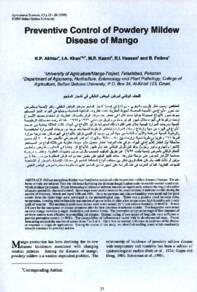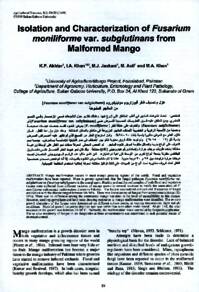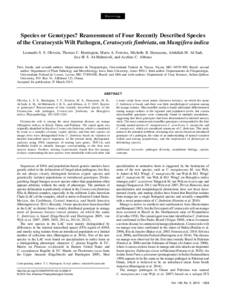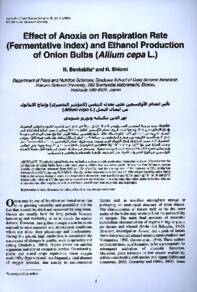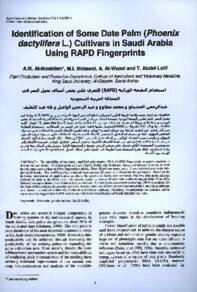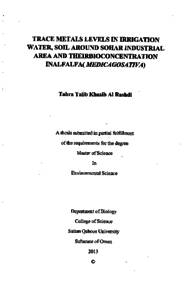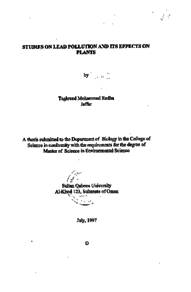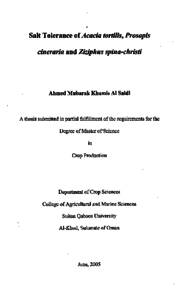Document
Preventive control of powdery mildew disease of mango.
Contributors
Publisher
Sultan Qaboos university
Gregorian
1999
Language
English
English abstract
Oidium mangiferae Berthet was found to be associated with the powdery mildew disease of mango. The air- borne conidia are released from the old tissue harboring the dormant fungal hyphae under favorable weather conditions, which produce the disease. Proper forecasting of release of airborne innoculum significantly reduced the required number of sprays needed for chemical control. Spore traps were used to monitor the concentration of airborne conidia during the months of February, March and April 1996 and 1997. Daily temperature and relative humidity were noted and the spore counts from the spore traps were correlated to the meteorological data. There was a positive trend between rising temperature, lowering relative humidity and number of spores in the air after a low temperature, high humidity and cloudy spell of weather. The maximum spore occurrences were noted around 25 °C and relative humidity of 40-60%. It took 5-8 days for the emergence of discase symptoms after the first detection of airborne conidia, Ten fungicides were tested on three mango varieties (Langra, Dashehari, and Anwar Retol). The preventive sprays at the stage of first detection of air born conidia were effective in controlling the discase. Optimal timing of two sprays of fungicide were sufficient to provide preventive control (>90%). The susceptibility of inflorescence varied with its developmental stage. Proper forecasting reduced the number of sprays from 7 to 2 or 3. There was no varietal difference in incidence of the disease or response to fungicide applications. During the course of this study, we identified seedling plants which consistently showed resistance to powdery mildew.
Member of
ISSN
2410-1079
Resource URL
Citation
Akhtar, K. P., Khan, I. A., Kazmi, M. R., Hassan, R. J., & Fatima, B. (1999). Preventive control of powdery mildew disease of mango. Journal of Agricultural and Marian Sciences, 4 (1), 23-28.
Arabic abstract
يتسبب فطر (لو بديم مانجفري - بيرثت) في إصابة أشجار المانجو بمرض البياض الدقيقي، وتتم الإصابة بالمرض عند تحرر الأبواغ من الأنسجة الحاضنة للخيوط الفطرية، تحت الظروف المناخية المناسبة، وحملها في الهواء. التنبؤ السليم بموعد تحرر الأبواغ المحمولة هوائيا ساعد كثيرا في خفض عدد مرات الرش بالمبيدات الفطرية. تم استخدام مصايد الأبواغ لرصد تركيزها في الهواء خلال شهور فبراير ومارس وأبريل من عامي 1996 و1997. كما تم رصد معدلات الرطوبة النسبية ودرجات الحرارة اليومية خلال نفس الفترة وذلك لمعايرتها بتركيز الأبواغ في الهواء. كانت العلاقة إيجابية بين عدد الأبواغ في الهواء من جهة وارتفاع درجات الحرارة وانخفاض الرطوبة النسبية بعد موجة من درجات الحرارة المنخفضة او الرطوبة النسبية المرتفعة والأجواء الغائمة من جهة أخرى، ووجد أن أقصى تركيز للأبواغ في الهواء كان عند درجة حرارة قدرها 25م° تقريبا ورطوبة نسبية تراوحت بين 40- 60%، وظهرت أعراض المرض في الأشجار بعد 5 - 8 أيام من ملاحظة أول انتشار للأبواغ في الهواء. تم في هذه الدراسة اختبار مفعول عشر مبيدات فطرية على ثلاثة أنواع من المانجو (لانجرا وأشهاري وأنور ريتول)، ولقد كان للرش الوقائي عند أول ظهور للأبواغ أثرا إيجابيا في التحكم بالمرض، وأمكن التحكم الوقائي بالمرض (بنسبة بلغت 99%) عن طريق التوقيت المناسب بالرش مرتين بالمبيدات الفطرية. وتعتمد درجة حساسية الأزهار للمرص على مرحلة تطورها. مساعد التنبية السليم على خفض عدد مرات الرش المطلوبة من سبعة إلى مرتين أو ثلاث فقط، ولم تكن هناك فروق تذكر بين مختلف الأنواع المختلفة للمانجو في معدلات الإصابة بالمرض والاستجابة للمبيدات الفطرية. كما تم التعرف في هذه الدراسة على شجيرات من المانجو أظهرت مقاومة مستمرة لمرض البياض الدقيقي.
Category
Journal articles

